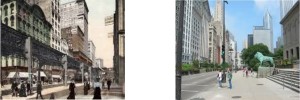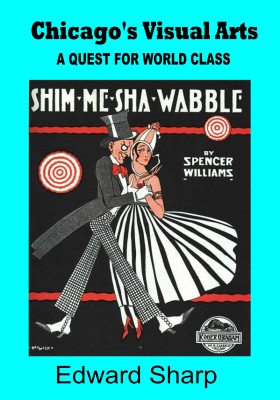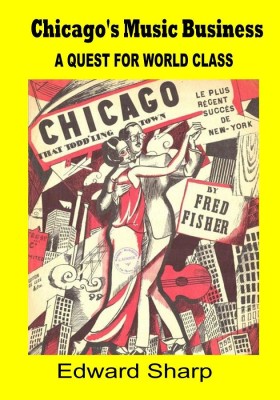It is the best of streets; a block west it is the worst of streets. It is the street the city shows to the world; a block west is the street the city has forgotten. Two streets in Chicago with a common alley but not a shared history. One is guarded by bronze lions the other is pierced by iron girders. Michigan Avenue is fine arts and the Mag Mile. Wabash Avenue is three train stops on an old elevated transit system. Michigan Avenue is the façade the City wants the world to see. Wabash Avenue is the space between Magnificent Michigan Avenue and State Street that great street.
They are a symbol of a city of contrasts. Michigan Avenue is the place of great cultural institutions while Wabash was the place of successful cultural businesses. The art collected by the City’s wealthy is displayed in a Michigan Avenue building that recalls ancient Rome. Yet directly north and west were great commercial art shops whose commissioned art influenced American imagery in fashion and literature.
Across Michigan Avenue from the Institution of great art, the first endowed American municipal orchestra performs. Near it, a building named for and dedicated to the fine arts was home to one of America’s oldest and most respected musical conservatories. Aspiring musicians have come to Michigan Avenue to be steeped in classical music while poor Delta blues singers walked from the Illinois Central to Wabash Avenue to be recorded. Classical German music would be presented on Michigan Avenue while America would consume the music of Wabash Avenue, it was Chicago’s Tin Pan Alley, its Piano Row, its Record Row. It was one of the incubators of Jazz.
In the Michigan Avenue building to the fine arts, Harriet Monroe’s little journal of poetry would garner a small following across the world, her friends would meet in the Caxton Club to promote the publication and collection of great books and Francis Fisher Browne would sell these books in a store designed by Frank Lloyd Wright. A block west on Wabash, McClurg was publishing Westerns, Science-Fiction and Action Adventures that would be read by millions around the globe. Volland was publishing Raggedy Ann stories that would be read by several generations of American children. Reilly and Lee was publishing Wizard of Oz stories that are still current. The “true detective” story was a Chicago innovation of popular fiction publishers.
In the same Michigan Avenue building where classical music is taught and poetry was published, the first American “little theater” presented classical Greek dramas and started a movement of little theaters across America. On Wabash, theater producers presented comic operas with casts that equaled in magnitude the entire audience in the Little Theater. The American musical extravaganza and the American comic opera were innovations of Chicago commercial producers west of Michigan Avenue.
The cultural institutions of Michigan Avenue, with the Wacker Drive based Lyric Opera included, form the basis of Chicago’s boosters’ claim of “world-class” status. These endowed institutions are Chicago’s self-described “cultural jewels” and are widely admired for their excellence, but they never have had much of a national or global impact. The cultural enterprises based on or near Wabash Avenue have had a profound effect on the nation’s popular cultural especially in music and literature and yet is little known even in Chicago.
The story of Chicago’s fine arts community has been told many times and from sundry perspectives, while the popular culture history has been regularly ignored, the books in the Quest for World-Class series, Chicago’s Visual Arts, Chicago’s Music Industry, Chicago’s Theater Industry, Chicago’s Motion Picture Production History, Chicago’s Radio and Television Industry History, Chicago’s Literary Publishing History, and Magazine Publishing in Chicago is meant to correct this imbalance. You really don’t know Chicago if you haven’t read these books.



